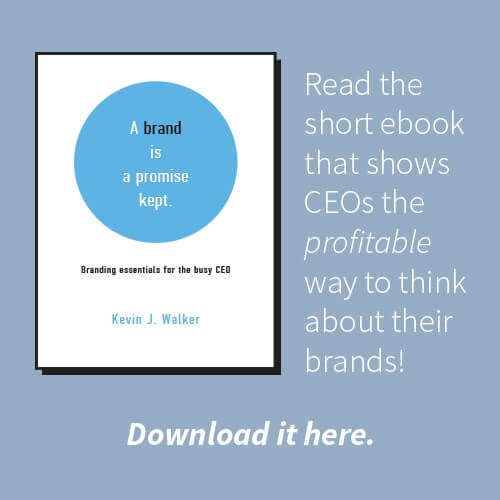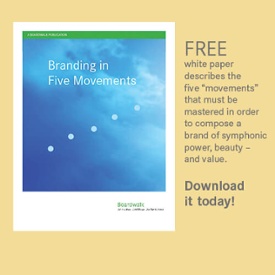 Branding is about simplicity and focus. You have to ask what it is about your business, product or service that satisfies your customers better than anyone else. What’s the real reason they keep coming back again and again? It’s not always easy to come up with an accurate answer. But when you do find it, and can articulate it in a clear and simple positioning statement, you have the beginning of a viable brand strategy. Now you can begin your messaging, your marketing, your advertising, your communications. And that costs money, right? Of course it does but, surprisingly, businesses that have formalized their brand strategy spend far less on marketing than their competitors who think they can succeed without one. And they get a much higher ROI on their marketing spend.
Branding is about simplicity and focus. You have to ask what it is about your business, product or service that satisfies your customers better than anyone else. What’s the real reason they keep coming back again and again? It’s not always easy to come up with an accurate answer. But when you do find it, and can articulate it in a clear and simple positioning statement, you have the beginning of a viable brand strategy. Now you can begin your messaging, your marketing, your advertising, your communications. And that costs money, right? Of course it does but, surprisingly, businesses that have formalized their brand strategy spend far less on marketing than their competitors who think they can succeed without one. And they get a much higher ROI on their marketing spend.
Every brand has constituencies. For a typical business, these may be:
- Customers/clients
- Founder/owner/CEO
- Top lieutenants (C-suite)
- Middle managers
- Rank and file employees
- The job-seeking community/potential employees
- Shareholders/financiers/bankers
- Board of directors
- Advisory board
- Vendors
- Competitors
- The press
- Regulatory agencies
All these different constituencies relate to the business in different ways. They perceive the business from different perspectives. More than that, they probably have different feelings about the company. The CEO needs to manage all these different feelings and points of view because the success of the company is, in a very real way, dependent on those perceptions. In an ideal world, all these constituencies would share a single, positive opinion of the brand.
A brand strategy creates a single, focused, clear and concise message that is equally compelling to all constituents. It allows the business to address the entirety of its constituencies with one message, instead of having one campaign to attract customers, another to satisfy employees and yet another to woo top talent. When you skip over creating a brand strategy, your messaging loses focus almost immediately and you find yourself marketing in the dark, creating and abandoning campaigns, wasting money. But the formal brand strategy serves as a focusing agent, aligning the opinions of all the constituencies to a shared point of view and, if you’ve been doing it right, a positive one at that. Needless to say, a single campaign is much less expensive than multiple messaging efforts.
Moreover, most CEOs think of their brand as an outward-looking tool, a face with which their business can approach customers. But the brand is also vital for solving one of the thorniest challenges that face modern businesses today – the never-ending effort to attract and retain top talent.
According to the National Center for the Middle Market, fully 50% of candidates who turn down job offers do so because they don’t like the employer’s brand. Even though everything about the offer is otherwise perfectly satisfactory, they just can’t imagine themselves working for the company that made the offer. So, to land more of the employees they want, employers need to work on their brands. And that pays off in smarter, more motivated employees who fit with the company and its culture from day one – employees that cost less to train and who are likely to stay with the company for much longer.
Brand strategy saves money by reducing the amount of effort it takes to reach multiple constituencies, by making that communication more resonant and effective, by attracting and retaining top talent and by reducing the HR costs associated with on-boarding new hires.
The brand strategy can also save money by preventing the business from making costly decisions, causing it to wander into off-brand territory. But we’ll save that for part seven of this series.
________________________________________
This is the third of an eight-part series, outlining the eight major benefits of branding. Can’t wait to learn about all eight benefits of branding? Download them here.
Best branding reads – week of March 7, 2016
The Language of Branding: Verbal Identity in the Chinese Market
Give your brand a Chinese name, or someone else will do it for you.
3 Ways To Build A Sentimental Brand
Tradition. Culture. Endurance. Unity. Good foundations for a brand.
he New Power of Brand Design: Branding Roundtable #19
At least watch the short video. The ebook is worth reading too.
Choosing The Right Brand Values
Brands should not get too comfortable. Nor should they abandon what works.
A terrible, terrible way to extend your brand. Lazy is not a strategy.
Do Men Need Their Own Detergent Brand?
I’d do the wash more often, honey, if only I could feel more manly about it.
No Brand Is Safe in the “Age of Disruption”
Brands should disrupt themselves or someone will do it to them.




